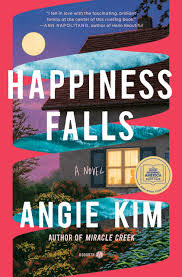Common Text Study Guide

Each year Loyola chooses a Common Text for all first-year students to read before the Fall semester begins. The book chosen for your incoming class, by a committee of current Loyola students, faculty, and staff, is Happiness Falls, by Angie Kim. Happiness Falls explores love, communication, and family dynamics, through a compelling mystery that will have you racing to the last page.
During Fall Welcome Weekend, the Class of 2029 will convene on campus, and you will discuss the Common Text with your academic advisor, who is also one of your professors, and your fellow students in your Messina group. It is important that you read the text with care and come prepared to discuss the ideas presented in this study guide. The Common Text is intended for reading by everyone in your class and may be included in Messina course discussions, tests, or assignments during Fall and/or Spring semester. Messina will also sponsor events throughout the year to address themes raised in the text.
Before you read
- What do you know about neurodiversity? What sources do you get your information from?
- What are some assumptions we make about people when we see them for the first time?
- What are some struggles or concerns that some people may experience that others do not, or cannot, see?
While you read
- How do the siblings and their relationships shape their interactions with each other and their experiences within the story?
- How would you describe Mia’s narration style? What are some of Mia’s blind spots in terms of how she perceives and interprets what is happening?
- How does the novel explore the challenges faced by those with disabilities and their families?
- How does the novel explore the concept of happiness and its relationship to individual experiences and perceptions?
After you read
- What are your thoughts on Adam's Happiness Quotient project? Do you find his theories compelling?
- How does the novel explore the complexities of forgiveness and reconciliation within a family?
- How does the novel depict the impact of race and mixed-race identities on the characters' experiences?
Engage Further
- Read more about Angelman Syndrome on the Mayo Clinic’s website and explore therapy activities for working with non-verbal children.
- Did you know there are regular gatherings for twins all over the world? The biggest is the Twins Days Festival in Ohio. Also, meet Malik and Miles, identical twins studying biological engineering at MIT who run a funny science education account on Instagram.
- Learn more about rich history of the Korean American experience in Baltimore. Author Angie Kim immigrated from Korea to a suburb of Baltimore as a preteen.
- Do you love true crime media? You are not alone. A recent episode of the video and audio podcast “What in the World?” from the BBC explores the appeal of true crime stories. Mysteries of all kinds are among the most popular books, movies, and television shows around the world and a Psychology Today column explores some of the reasons why.
- Take a look through Loyola’s course catalog to explore some of the courses focused on similar themes and content, including:
- SC204 The Family
- SP102 Introduction to Human Communication
- FO100 How to Get Away with Murder (Or Not)
- EN380 Neurodiversity: Mental Disability in Literature and Film
- MU201 Music Fundamentals
- TH244 Forgiveness and Reconciliation
- WR378 Thinking about Crime Fiction
Questions?
Contact the Messina Office at 410-617-2669, messina@loyola.edu, or browse the website for a list of academic and support services available to Loyola students, including helping you make the transition to campus and college life.